
- Home
- News
- Analysis
- States
- Perspective
- Videos
- Education
- Entertainment
- Elections
- World Cup 2023
- Features
- Health
- Business
- Series
- Economy Series
- Earth Day
- Kashmir’s Frozen Turbulence
- India@75
- The legend of Ramjanmabhoomi
- Liberalisation@30
- How to tame a dragon
- Celebrating biodiversity
- Farm Matters
- 50 days of solitude
- Bringing Migrants Home
- Budget 2020
- Jharkhand Votes
- The Federal Investigates
- The Federal Impact
- Vanishing Sand
- Gandhi @ 150
- Andhra Today
- Field report
- Operation Gulmarg
- Pandemic @1 Mn in India
- The Federal Year-End
- The Zero Year
- Premium
- Science
- Brand studio
- Home
- NewsNews
- Analysis
- StatesStates
- PerspectivePerspective
- VideosVideos
- Entertainment
- ElectionsElections
- Sports
- Loading...
Sports - Features
- BusinessBusiness
- Premium
- Loading...
Premium
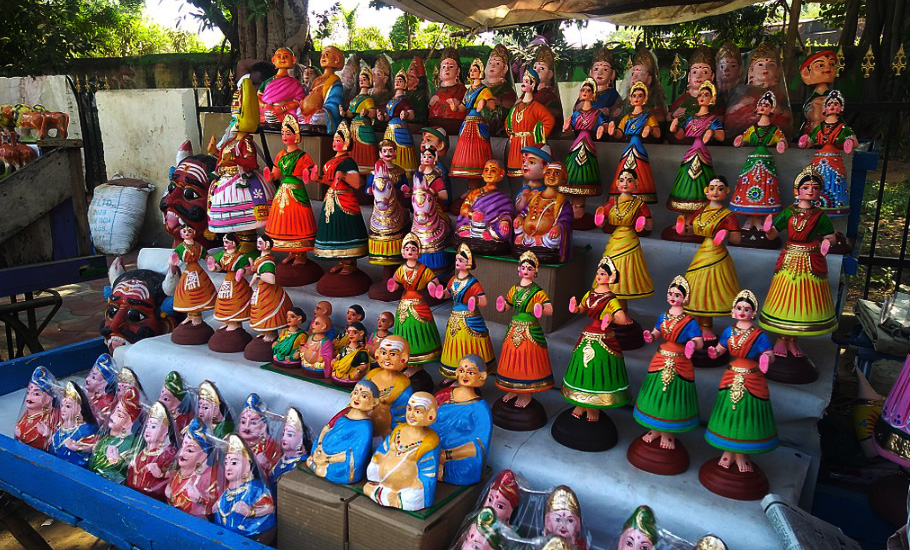
How Thanjavur dolls took a satirical dig at Maratha rulers

The traditional Thanjavur doll with its bobblehead has for centuries fascinated kids and regaled elders alike. Its roly-poly form and imperfectly perfect shapes have caused amusement and left people smiling. But the story of why the doll’s head moves is even more interesting than just sitting and marvelling at the doll. The Chettiyar Bommai dolls today are seen to many as an ode to the...
The traditional Thanjavur doll with its bobblehead has for centuries fascinated kids and regaled elders alike. Its roly-poly form and imperfectly perfect shapes have caused amusement and left people smiling. But the story of why the doll’s head moves is even more interesting than just sitting and marvelling at the doll.
The Chettiyar Bommai dolls today are seen to many as an ode to the rich business heritage of the Chettiar community in south India.
Every Navratri people scrape through the lofts in their homes and fish out the vibrantly colourful, yet odd looking dolls, and place it in their golu (a display of dolls). They usually associate the doll representing male and female figurines of the Chettiyar community as the Thanjavur Thalaiyatti Bommai (dolls which nod their head).
While the dolls today have largely been reduced to ceremonial figures, coming to life only once a year during Navratri, Thalaiyatti Bommai were once part of households through the year in the united Thanjavur region, considered to be south India’s granary in the yesteryears. The doll would enjoy a place of prominence in every home, all through the year. The original Thalaiyatti Bommai was not the Chettiyar Bommai. Instead it was in the form of a king and queen figurine with a large circular base which was called Uruttu Bommai (rolling doll). No matter which side it was pushed to, the doll would regain its original erect pose.
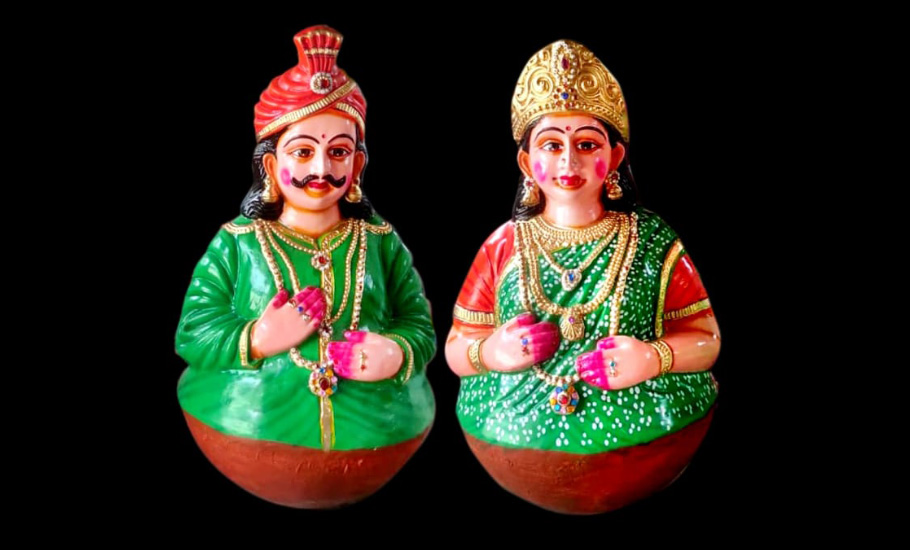
“As a kid, I used to be fascinated by Thanjavur Thalaiyatti Bommai and it will never lose its charm for me,” said PB Rithikaa, a student of Class 12 in Chennai. “Any doll which is eye-catching, exciting, colourful and mesmerizing would attract children. That’s why I think Thalaiyatti Bommai caught my fascination. And I feel it will never lose its charm,” Rithikaa says. “Thalaiyatti Bommais are not just beautiful, they are also unique. They are animated objects because of their movements, which makes playing with them even more joyful.”
The satirical moves
The artistic Thanjavur dolls (Thalaiyatti Bommai) which come in vibrant colours and gravity defying designs have lost most part of their history and relevance over time.
But there was a time when the doll’s movements indicated satire. While the Tamil name Thalaiyatti Bommai literally translated to dancing dolls, it conveyed a satirical take on the power structure prevalent 200-250 years ago. The doll making which is said to have evolved centuries ago as a humorous attack on the then Maratha rulers who paid obeisance to the British rule said Mani.Maaran, researcher and an expert in manuscript reading at the acclaimed Sarasvati Mahal Library, Thanjavur.
“The dolls are symbolic of how the powerful Maratha rulers danced to the tunes of the British raj. The rulers under the British government didn’t have any say either in the administration or deciding the law of the land. Artists of the era made fun of how the kings were reduced to being yes-men of the British and the dolls emerged as a way to take a dig at the rulers,” he said speaking to The Federal, tracing the oral history passed on through centuries.
Thalaiyatti in Tamil also refers to a person who nods before the powers that be.
The dolls thus emerged as a unique combination of artistry and political satire narrating people’s history.
Interestingly, Marathas who ruled over Thanjavur from 1676 onwards were connoisseurs of art. They celebrated the dancing dolls, apart from Thanjavur paintings and other art forms, despite the subtle criticism they carried.
“Our forefathers told us that the survival of the doll making owes much to the patronage of Maratha Serfoji kings,” said S Boopathi, a traditional Thanjavur doll maker. “I am a fifth generation Thanjavur doll maker. Even though three varieties of Thanjavur dolls are popular today, we largely make the traditional gravity defying rolly-polly dolls (Uruttu Bommai). That is the traditional Thalaiyatti Bommai with the king and queen figurine,” he added.
Thanjavur dolls come in three patterns today. The whole doll ‘dances’ in the traditional Uruttu Bommai variety. The second form makes use of strings inside the doll to ensure the head bobbles. In the third version, both the head and hip portion of the doll ‘dance’. It is called the dancing girl and can be found in many Bharatha Natyam postures. Only the first one is the traditional Thanjavur Bommai. The other two were additions of the later period. The unique thing about all three versions, however, is that they are all handmade and hand painted.
Thalaiyatti Bommai is unique to Thanjavur as it is made with the alluvial soil flushed in by the Kaveri river into the delta. In some cases, the doll’s top portion is today made with plaster of Paris and paper mache to reduce weight. But the traditional practice of using clay to the base is still followed by most doll makers. “Our forefathers used coconut shells as the base to create a perfect balance. But finding a perfectly shaped coconut shell or shaping it to perfection is difficult and time consuming. So, now-a-days we use clay to prepare the bottom of the dolls,” said Boopathi, who has received a state award for his craftsmanship.
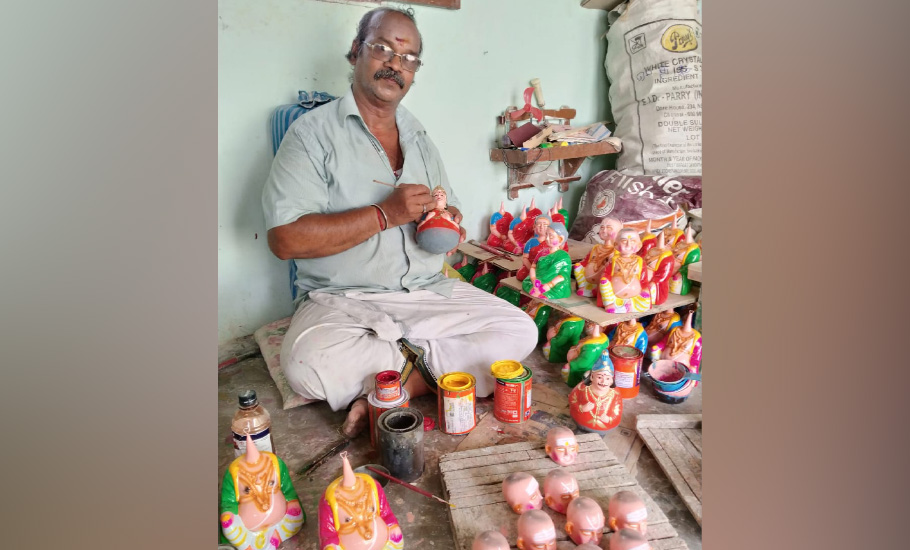
Unlettered craftsmen mastering the principle of equilibrium has been one of the most fascinating aspects of doll making. For instance, Boopathi doesn’t have any idea of the science behind gravity.
“We just ensure weight is evenly distributed across the four sides of the doll. We don’t know the science behind it. We just follow what our forefathers taught us,” he said.
Thanjavur dancing doll is the only puppet in the list of 45 products which have a Geographical Identification (GI) tag from Tamil Nadu.
The threat to the art
But the traditional doll making in Thanjavur today is restricted to Mariamman temple in the town. “Chennai, Cuddalore and Puducherry contribute more to Thalaiyatti Bommai production. What is manufactured in Mariamman temple is rather small in quantity,” said Mani.Maaran.
People prefer the dolls for their uniqueness.
“A doll made in thousands using a single mould doesn’t interest me when I buy it for my kids,” says M Bhuvaneswari, a social worker from Chennai. “Thalaiyatti Bommais are etched in my childhood memory. Today, I like them for additional reasons. They are eco-friendly, biodegradable and a proof of local wisdom,” she said.
The arrival of plastic dolls and battery-operated toys are proving to be a challenge for the existence of traditional Thanjavur dolls. Produced in assembly lines, many of the plastic dolls are sold as low as Rs 20, especially in and around temples, which poses a huge challenge for Thalayatti Bommais, which cost more than Rs 150 per doll. The doll makers have dwindled in numbers unable to keep up in the competition from plastic dolls.
“Not more than 50 families are involved in making the dolls in Thanjavur district today. But in the past there used to be 150 families in Thanjavur alone,” said Boopathi. Had it not been for the patronage of Serfoji kings in the 19th century, the dolls may not have made it till today.
“Conscious buying of dolls has given way to buying patterns solely based on cost. Tourists coming to Thanjavur are our lifeline and kids love our dolls but given the wide price gap between plastic dolls and Thanjavur dolls, parents seldom prefer traditional dolls,” said Boopathi. “Many parents convince their children to buy cheaper dolls to save money. This trend has hit us hard. We haven’t recovered back to pre-Covid business,” he said.
The artisans say they need systemic help in boosting exports, as people living out of the country might be interested in the art and would be able to afford it.
Thanjavur doll making is a labour-intensive — involving multiple members of a doll-making family — time-consuming process with very low returns. After sourcing the right form of clay, curating it, giving it a shape, allowing it to dry, using a plain coating of paint and finishing it with a colourful final coating, they need time to dry.
The doll-making process comes to a halt during monsoons and cyclones, taking away many days from the artisans. The artisans say they have to spend 10 days making 100 dolls. “We sell them to retailers at Rs 100 per doll,” said Boopathi. Using machines, he says, is not going to help them as it will strip the dolls of their uniqueness, making them all look the same.
The origin
There are conflicting views regarding the origins of the dolls. While some claim it evolved during the rule of the Cholas, Mani.Maaran rejects media reports which link Thanjavur dolls to Chola kings’ temple building pursuits.
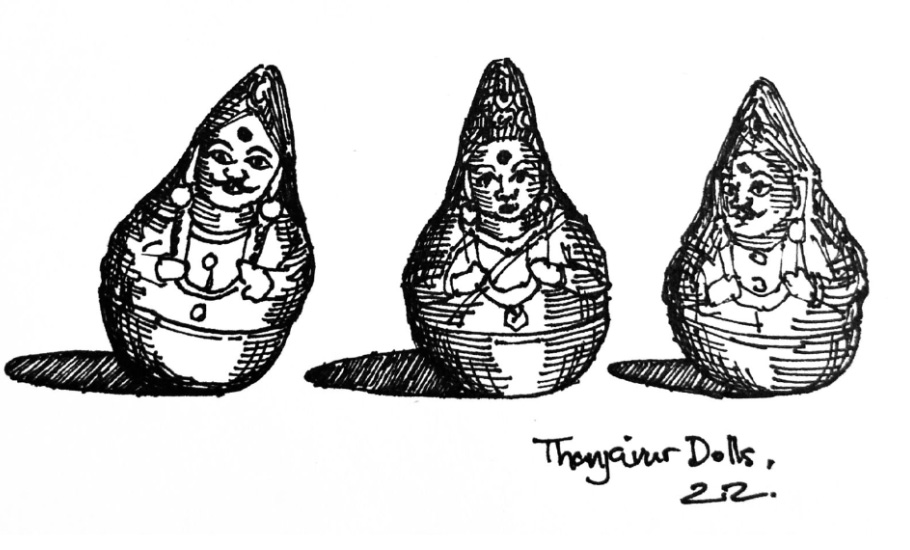
“The Cholas are known for their documentation. But there is not a single proof to say such dolls existed during their reign, either in stone inscriptions or palm leaf manuscripts. But there is a lot of proof from the oral tradition and folk tales which connect it to the rule of Serfoji kings. Also, the word Thalayatti doesn’t have any linguistic relevance that can be linked to the Cholas. Only during the Maratha rule there was a political compromise with the British colonists. Also remember, the first Thalayatti Bommai dolls were made on the king and the queen,” he said.
Thanjavur once contributed immensely to arts and culture. Thalaiyatti Bommais are an indelible part of this rich heritage. But the tradition is withering away. While some consciously do not buy plastic, machine-made dolls, their numbers are small.
Bhuvaneswari said that as a conscious person she didn’t buy her daughter a Barbie doll, as it is a mass produced product.
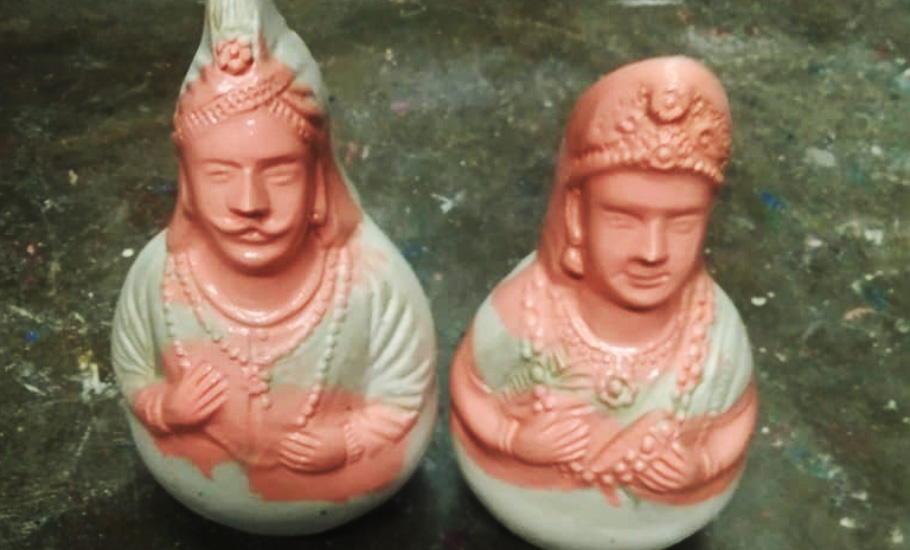
“I am saddened today to see shops filled with Chinese toys. These days I can’t see anything else in the shops. But if I have to give someone a special gift, Thalaiyatti Bommai will surely find a place on my list. Gifting Thalaiyatti dolls is special because it represents the culture and art of Thanjavur. People will always love to receive a gift that represents the speciality of a place,” Bhuvaneswari said.
Only when Bhuvanerswari’s tribe grows can the Thalaiyatti dolls find a lifeline.

